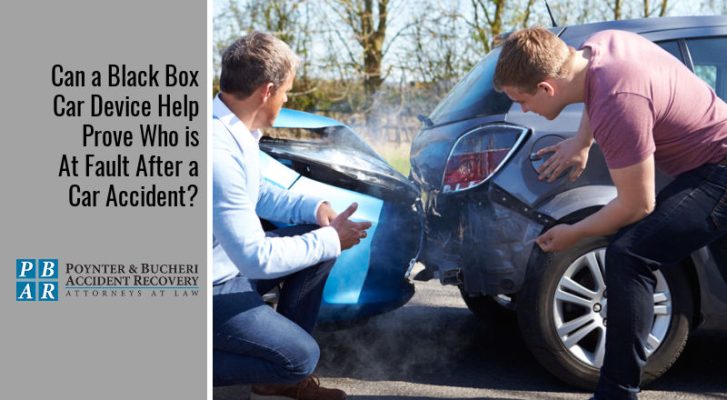
Can a Black Box Car Device Help Prove Who is At Fault After a Car Accident?

Most people have heard of black boxes when referring to airplanes, but it is a little-known fact that motor vehicles can have these devices as well. And when an accident occurs, the data recorded by a vehicle’s black box could potentially help when determining fault.
Read on to learn more about black box car devices and how they can be used to help prove fault after an accident. And if you have any further questions about an Indiana car accident claim, please reach out to our legal team at Poynter & Bucheri Accident Recovery for assistance.
What is a Black Box Car Device?
The devices in cars referred to as black boxes are officially called Event Data Recorders (EDR). These electronic devices started showing up in vehicles in the late 90s and are now present in the majority of modern cars.
The purpose of an EDR is to record data pertaining to the vehicle. Specifically, it records data in the 20 seconds before, during, and after a collision occurs. As such, this data can be helpful when determining what happened in a car accident and who is at fault.
What Can Black Box Car Data Show?
The recording of data is essentially linked to airbag deployment in a vehicle. However, the airbags do not necessarily have to be deployed for a black box car device to record information. There are two situations in which an EDR will record:
- A non-deployment event: This occurs when there is an accident, but the airbags do not deploy. In this case, pre- and post-crash data are still recorded.
- A deployment event: This happens when there is an accident that triggers airbag deployment. In this situation, data is recorded before, during, and after the collision.
There is no set standard for what an EDR can record. Thus, a black box in a car accident can record any number of things. The most commonly recorded data includes:
- Acceleration
- Speed
- Braking activity
- Seatbelt use
- Steering wheel angles
- Throttle position
- Vehicle tilt
- Force of impact
- Airbag deployment
Can You Use a Black Box in a Car Accident to Prove Fault?
If you are injured in an accident and seeking to file a claim to recover compensation for damages, black box car data could help. However, recovering an EDR after an accident and downloading the information it recorded is not easy.
If you need to obtain the EDR from another driver’s vehicle, you will need the help of an attorney to obtain permission to gain access. Essentially, you will need to be granted consent and send a request to the court in accordance with Indiana state law.
Once you and your attorney have obtained the EDR data, it can then be used as evidence to help you build a strong case and prove what happened. For example, if another driver is lying about speeding, the EDR in their car could prove that they were, in fact, speeding and thus responsible for the accident.
Keep in mind, however, that just as you and your lawyer can obtain information from another driver’s EDR, so can another party involved in the accident gain access to your vehicle’s EDR. This means your black box car data could also reveal information that could be used against you.
So, when asking for permission to use black box car data as evidence, do so wisely and consult with your attorney first. An attorney can advise you on your best options and what steps to take to ensure the best outcome for your case.
Consult With an Indianapolis Car Accident Accident Lawyer
If you need access to a black box in a car accident, our team can help. Our legal experts at Poynter & Bucheri know how to obtain EDR data in accordance with Indiana state law and how to use that data to help you build a strong case.
Don’t hesitate — an experienced Indiana car accident lawyer can assist you right away. Call 1-800-265-9881 for a free case review.
